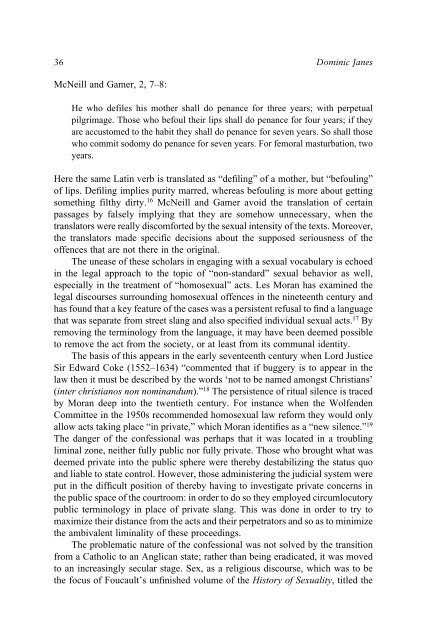Medieval Sexuality: A Casebook - Julian Emperor
Medieval Sexuality: A Casebook - Julian Emperor
Medieval Sexuality: A Casebook - Julian Emperor
Create successful ePaper yourself
Turn your PDF publications into a flip-book with our unique Google optimized e-Paper software.
36 Dominic JanesMcNeill and Gamer, 2, 7–8:He who defiles his mother shall do penance for three years; with perpetualpilgrimage. Those who befoul their lips shall do penance for four years; if theyare accustomed to the habit they shall do penance for seven years. So shall thosewho commit sodomy do penance for seven years. For femoral masturbation, twoyears.Here the same Latin verb is translated as “defiling” of a mother, but “befouling”of lips. Defiling implies purity marred, whereas befouling is more about gettingsomething filthy dirty. 16 McNeill and Gamer avoid the translation of certainpassages by falsely implying that they are somehow unnecessary, when thetranslators were really discomforted by the sexual intensity of the texts. Moreover,the translators made specific decisions about the supposed seriousness of theoffences that are not there in the original.The unease of these scholars in engaging with a sexual vocabulary is echoedin the legal approach to the topic of “non-standard” sexual behavior as well,especially in the treatment of “homosexual” acts. Les Moran has examined thelegal discourses surrounding homosexual offences in the nineteenth century andhas found that a key feature of the cases was a persistent refusal to find a languagethat was separate from street slang and also specified individual sexual acts. 17 Byremoving the terminology from the language, it may have been deemed possibleto remove the act from the society, or at least from its communal identity.The basis of this appears in the early seventeenth century when Lord JusticeSir Edward Coke (1552–1634) “commented that if buggery is to appear in thelaw then it must be described by the words ‘not to be named amongst Christians’(inter christianos non nominandum).” 18 The persistence of ritual silence is tracedby Moran deep into the twentieth century. For instance when the WolfendenCommittee in the 1950s recommended homosexual law reform they would onlyallow acts taking place “in private,” which Moran identifies as a “new silence.” 19The danger of the confessional was perhaps that it was located in a troublingliminal zone, neither fully public nor fully private. Those who brought what wasdeemed private into the public sphere were thereby destabilizing the status quoand liable to state control. However, those administering the judicial system wereput in the difficult position of thereby having to investigate private concerns inthe public space of the courtroom: in order to do so they employed circumlocutorypublic terminology in place of private slang. This was done in order to try tomaximize their distance from the acts and their perpetrators and so as to minimizethe ambivalent liminality of these proceedings.The problematic nature of the confessional was not solved by the transitionfrom a Catholic to an Anglican state; rather than being eradicated, it was movedto an increasingly secular stage. Sex, as a religious discourse, which was to bethe focus of Foucault’s unfinished volume of the History of <strong>Sexuality</strong>, titled the













